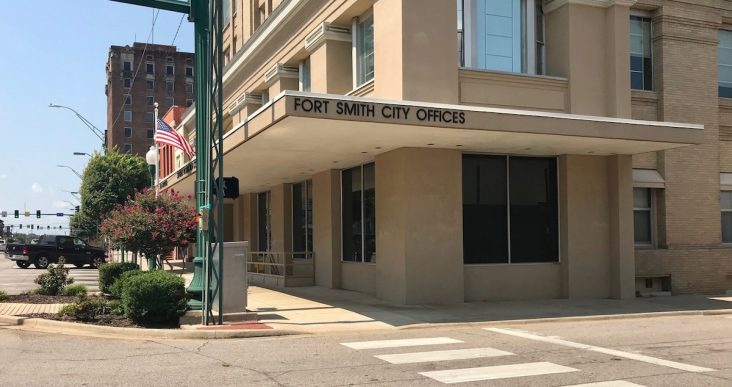Development on former Fianna Hills golf course property is tabled
by September 7, 2021 9:24 pm 3,815 views

A left turn lane could be a problem, which is why the Fort Smith Board of Directors on Tuesday (Sept. 7) tabled a master land use plan change for a commercial development on part of what was once the 18th tee box at the former Fianna Hills Country Club.
The board also on Tuesday approved an almost $2 million water utility extension that city administration believes is the best option to support ongoing and possible future development of the river front near downtown Fort Smith.
The tabled commercial development is at the southwest corner of Jenny Lind Road and Brooken Hill Drive. The preliminary plat lists the owner as Fianna Properties, LLC. The PZD would allow for a mix of light commercial, retail and professional office uses. Renderings submitted with the request call for a Fianna Hills Retail Development for the three lots in the request.
On May 18, the board approved resolutions allowing part of the former golf course to be replatted and included into residential lots, most likely ending the chance to reopen the Fianna Hills golf course. David Millé, owner of Fianna Hills Country Club and golf course, closed both Dec. 31, 2018. On-again and off-again efforts to buy the country club and golf course by a group of local investors fell through in September. Millé said in a letter to property owners Sept. 21 that he did not believe the investment group could make it work and began working to sell parts of the golf course to homeowners immediately adjacent to the course.
The Fort Smith Planning Commission approved what is a planned zoning district for the development, but City Director Kevin Settle said Tuesday a left turn into and out of the development off of Jenny Lind is a problem. He asserted that few Fianna Hills residents knew about the turn lane during the public hearings about the development.
“That should be a grave concern to the board. … I can see potential wrecks happening in this area,” Settle said, adding that many people “had no clue” about the “”predicament” of a left turn lane.
Pat Mickle, with Mickle Wagner Coleman, the civil engineering firm that designed the development, argued that the turn lane is 250 feet from the intersection stop light and the turn lane would prevent bottlenecks at the intersection.
The board voted 6-1, with Director Jared Rego voting no, to table the proposal until more people in the Fianna Hills area had a chance to learn about traffic patterns around the development.
WATER LINE EXTENSION
After much discussion about costs and alternatives, the board also approved a $1.941 million extension of a water line along Riverfront Drive near the city’s P Street wastewater treatment plant that would initially support a proposed RV park.
The park will be located just south of 330 acres the city purchased from Kansas City Southern Railroad Company for soft surface trails. The proposed park will include 107 paved RV parking spaces, 12 tent spaces, a swimming pool, restroom facilities and a playground. It will have a park-like setting and also will include a manager residence that will have an apartment, office and retail space.
Fort Smith Utilities Director Lance McAvoy said the project will provide critical “dual directional flow” in the area that will allow for better fire protection, maintain water pressure and allow for future economic development along the river front.
Directors George Catsavis and Lavon Morton expressed concern with the cost and the appearance of spending almost $2 million to support a development when developers are typically responsible for connecting to utilities. City Administrator Carl Geffken said the project will support more than the RV park. He said the area is the site of several future potential developments, including a “baseball stadium” which might be south of the RV park
“It comes down to economic development,” Geffken said, explaining why the city is paying for the project.
Fort Smith Mayor George McGill said boosting infrastructure in the area is the city’s push to “create a launch pad for development” in the area. The board voted 6-1, with Catsavis objecting, to approve the project.
